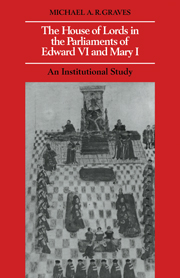Book contents
- Frontmatter
- Contents
- Dedication
- Preface
- Parliamentary sessions, 1547–8
- 1 Introduction
- 2 The composition of the House
- 3 The quality of the House
- 4 Attendance and activity, absenteeism and management
- 5 Cohesion and division
- 6 The Lords' inheritance: clerks and assistants to the House
- 7 The rules of business: procedure
- 8 The legislative record of the mid-Tudor Lords
- Abbreviations
- Appendix A Composition
- Appendix B Roll of the ‘actual’ members of the House of Lords, 1547–58
- Appendix C Attendance
- Appendix D Legislation
- Notes
- Select bibliography
- Index
7 - The rules of business: procedure
Published online by Cambridge University Press: 03 May 2010
- Frontmatter
- Contents
- Dedication
- Preface
- Parliamentary sessions, 1547–8
- 1 Introduction
- 2 The composition of the House
- 3 The quality of the House
- 4 Attendance and activity, absenteeism and management
- 5 Cohesion and division
- 6 The Lords' inheritance: clerks and assistants to the House
- 7 The rules of business: procedure
- 8 The legislative record of the mid-Tudor Lords
- Abbreviations
- Appendix A Composition
- Appendix B Roll of the ‘actual’ members of the House of Lords, 1547–58
- Appendix C Attendance
- Appendix D Legislation
- Notes
- Select bibliography
- Index
Summary
In the wake of W. Notestein it has become a sine qua non of Tudor parliamentary history that procedures were political weapons in a power-struggle between Crown and Commons. If actual confrontations and crises were relatively few, especially in contrast to the early seventeenth century, conflict was always inherent in a situation in which the monarch was on the defensive and the Lower House was probing and exploring new and enlarged frontiers of independence and authority. Moreover in this political treatment of parliamentary procedure it is not necessary to look beyond the House of Commons. The way in which a compliant upper chamber conducted its affairs is of little moment.
However, if the recent admixture of modest revision and more trenchant criticism is a reliable barometer, then the historical climate is changing. There is a dawning realisation that parliament was neither intended to be, nor was it in practice, a political arena and the occasion for a gladiatorial encounter between Crown and Commons. Rather it was, both in purpose and actuality, a market place for the transaction of an infinite variety of legislative business. It was not generally regarded as an opportunity to flex political muscle against the Crown, to indulge in opposition or to engage in blind political conflict. Instead, Tudor parliaments continued to be responsible assemblies characterised by co-operation between the monarch and the governing class.
- Type
- Chapter
- Information
- The House of Lords in the Parliaments of Edward VI and Mary IAn Institutional Study, pp. 141 - 172Publisher: Cambridge University PressPrint publication year: 1981

